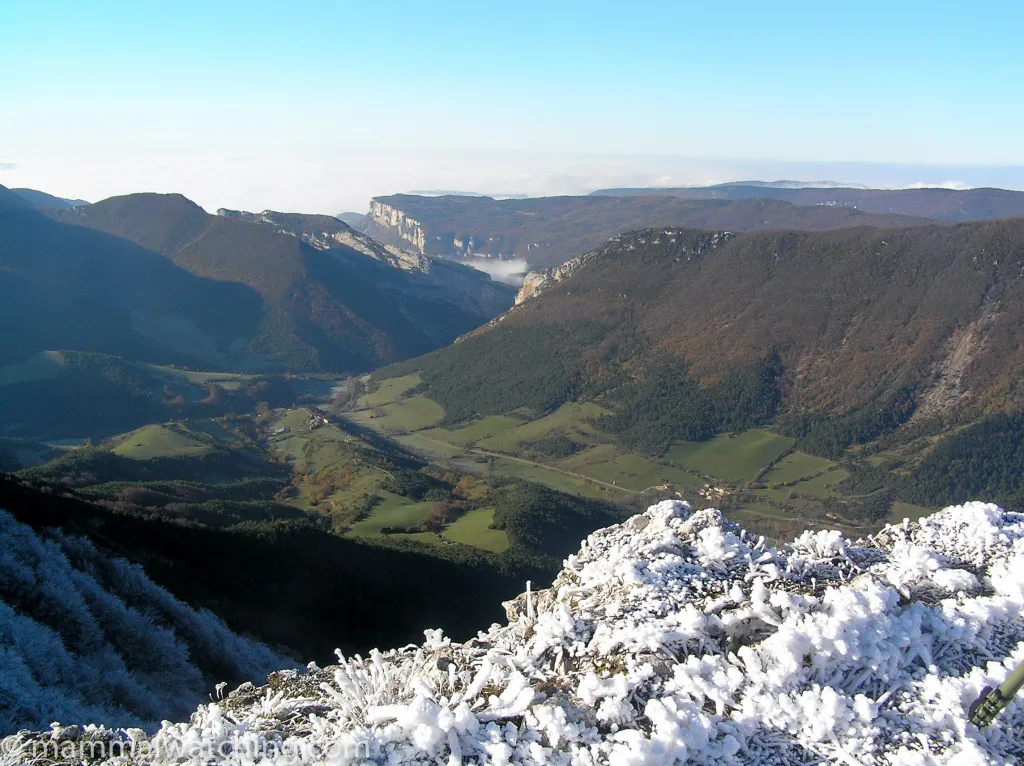
France
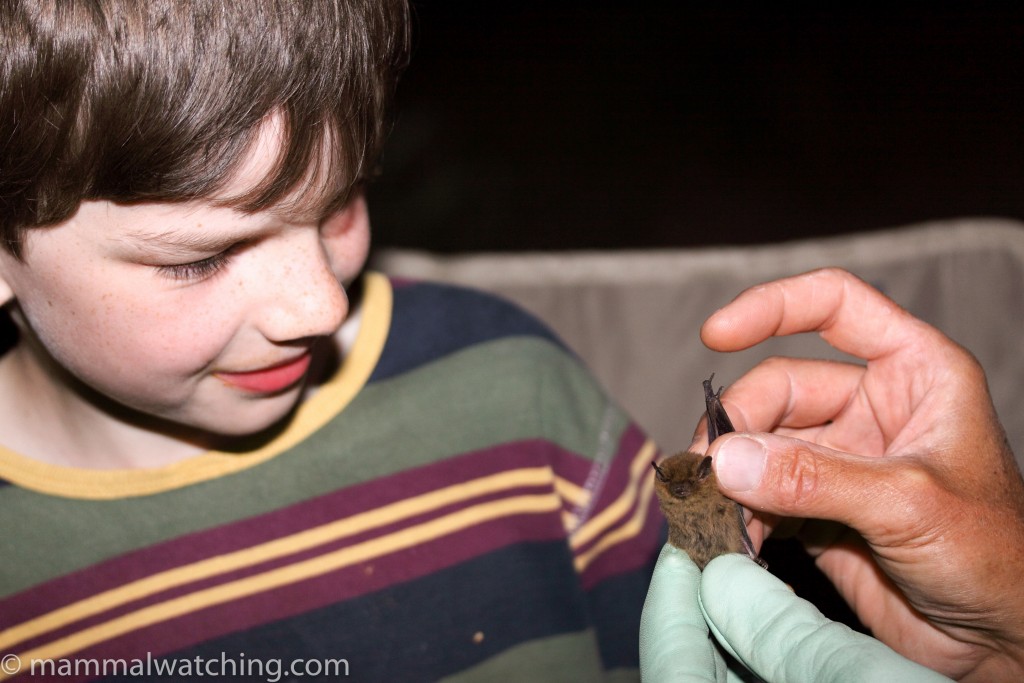
Patrick and a Pygmy Pipistrelle, Toulon
I lived in Paris from 2005 to 2011 and saw most of the country’s mammals.
The Southern Coast
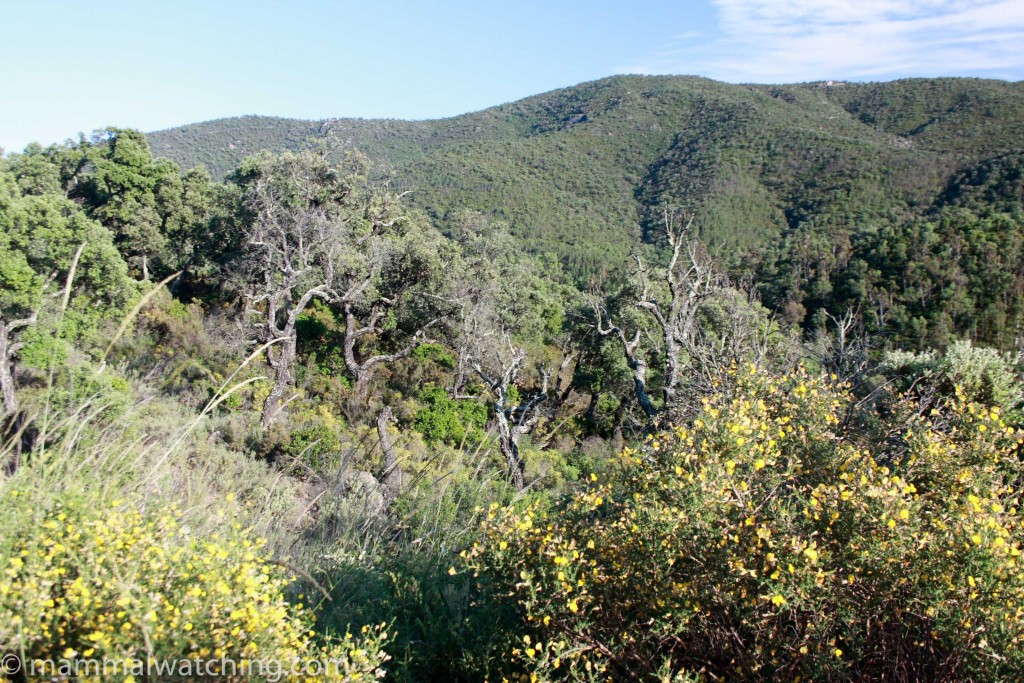
La Foret des Maures, near Toulon
In May 2009 I spent a weekend near Toulon on the southern coast of France. I’d been corresponding with fellow mammalogist Jean-Michel Bompar (JM) for a while and he reckoned that if I could find visit Toulon he might be able to find me a few new species. I booked a train ticket the next day.
JM picked us up – me and my 8 year old son Patrick – at Toulon station, which is 4 hours on the TGV from Paris. We headed straight out to try to mist net some bats at the Vallee de Sauvebonne near Toulon.
The 2008/09 winter was unusually wet and perhaps that was why there was very little flying around this usually reliable spot for bats. In a couple of hours we trapped just two Daubenton’s Bats and a Pygmy Pipistrelle.
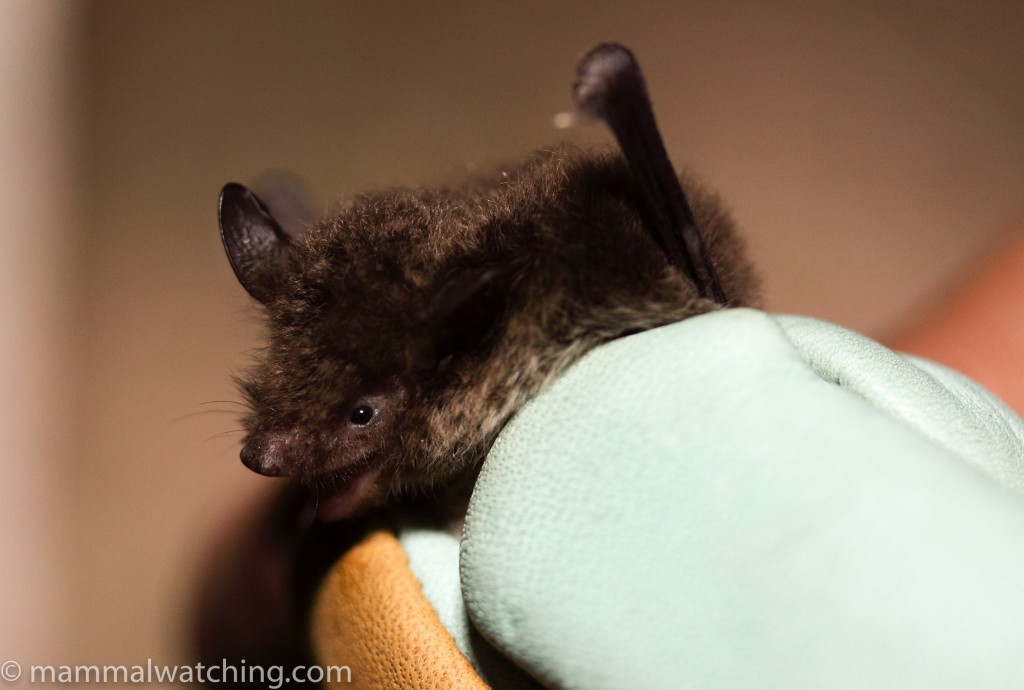
Daubenton’s Bat, Myotis daubentonii
The next day JM took us to a few roosting sites for some of the species I was after. He’d discovered a small roost of European Free-tailed Bats behind the shutters of a deserted house at La Billette and they were still in residence. Europe’s largest bat with an impressive set of teeth, and one for which very few roost sites are known.
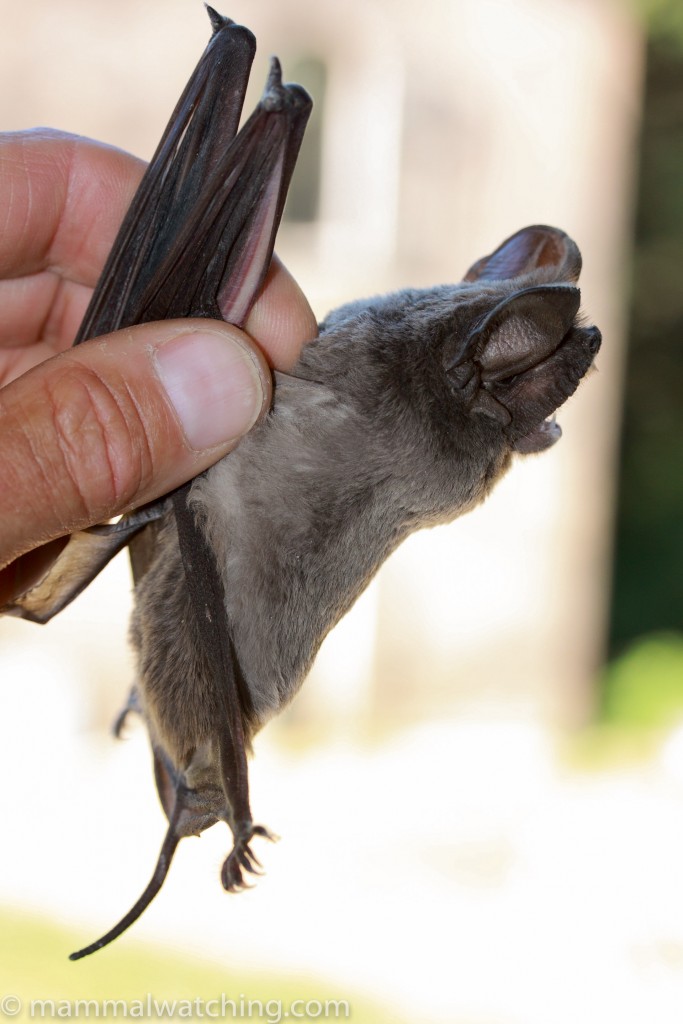
European Free-tailed Bat, Tadarida teniotis
There was also a smaller bat – possibly a Savi’s Pipistrelle – in the same house but it flew off when we tried to catch it.
Nearby, in a small holiday complex called Sigaloux, we visited a storage cellar to see if there were any Lesser Mouse-Eared Bats in residence. They are occasionally present but not that morning. All was not lost however, because in the afternoon we visited a more reliable spot: a cave called Grotte de Truebis, 2 km north of Sollies Toucas, on the right hand side of the road as you are heading north. Jean-Michel found us a few Lesser Mouse-eared Bats inside. The cave is soon to be gated to protect the bats from the locals who like partying at the entrance and throwing mud at the wildlife.
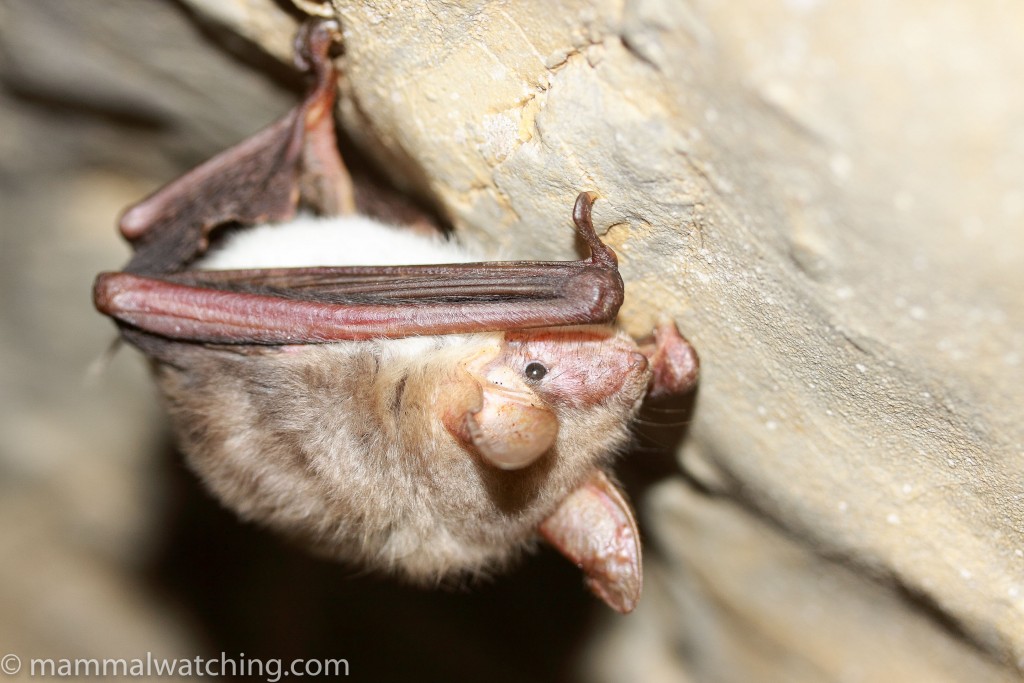
Lesser Mouse-eared Bat, Myotis blythii
That night we headed to another usually reliable spot to mist net. The Maison Forestiere des Caunes is a ranger station in the Foret des Maures. A beautiful spot. But despite sticking up three nets in a good location we didn’t catch a thing. Other battoes in the region were also trapping that night in other places and didn’t catch anything either, so something strange was going on. I saw an Edible Dormouse in a tree for a couple of seconds.
There are some nice small mammals in the forest including Algerian Mice (Mus spretus) and Etruscan Shrews (Suncus etruscus). We set traps the following night to try to catch them, but for only a few hours so it wasn’t altogether surprising that we couldn’t catch any.
On Saturday JM tried to find me some Grey Long-eared Bats. A cliff top trail near the mine museum at Le Pradet (the Mine de la Garonne) runs past a signpost to a gated cave just 300m from the car park. The cave is sometimes home to Grey Long-eareds …. but not when we were there. So we went on to visit an old mine called Mine de Valcros, at La Londe des Maure. After giving up because it was empty save for one Lesser Horseshoe, JM spotted a Grey Long-eared Bat on the way out. Phew! I think JM was more relieved than me.
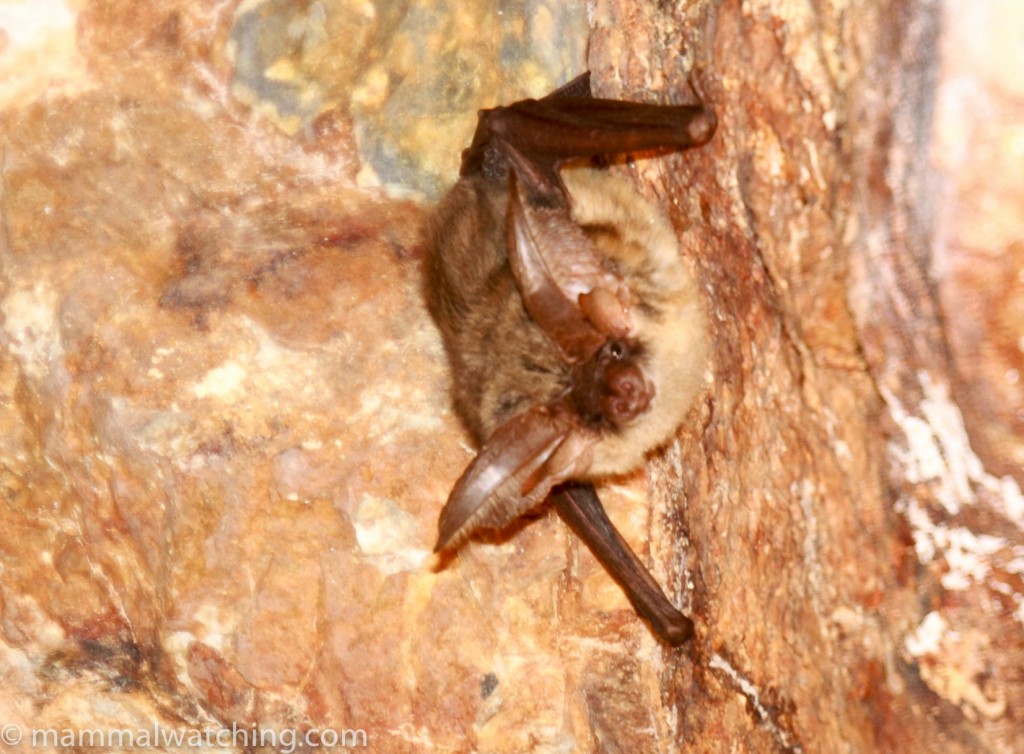
Grey Long-eared Bat, Plecotus austriacus
That evening we returned to the La Foret des Maures. Dominique Guicheteau, who is in charge of the park, set up a mist net while we waited for Kuhl’s Pipistrelles to emerge from their roost under his garage roof.
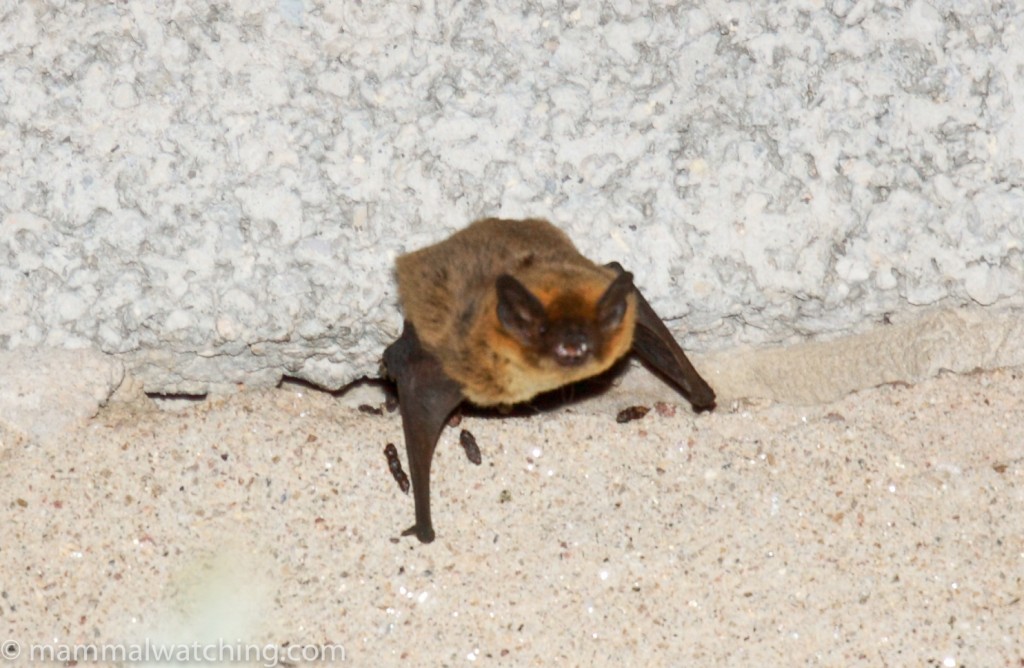
Kohl’s Pipistrelle, Pipistrellus kuhlii
The bats emerged before 10 p.m. and a couple of blurred pictures were good enough to show the white line on the edge of the wing membrane confirming they were this species.
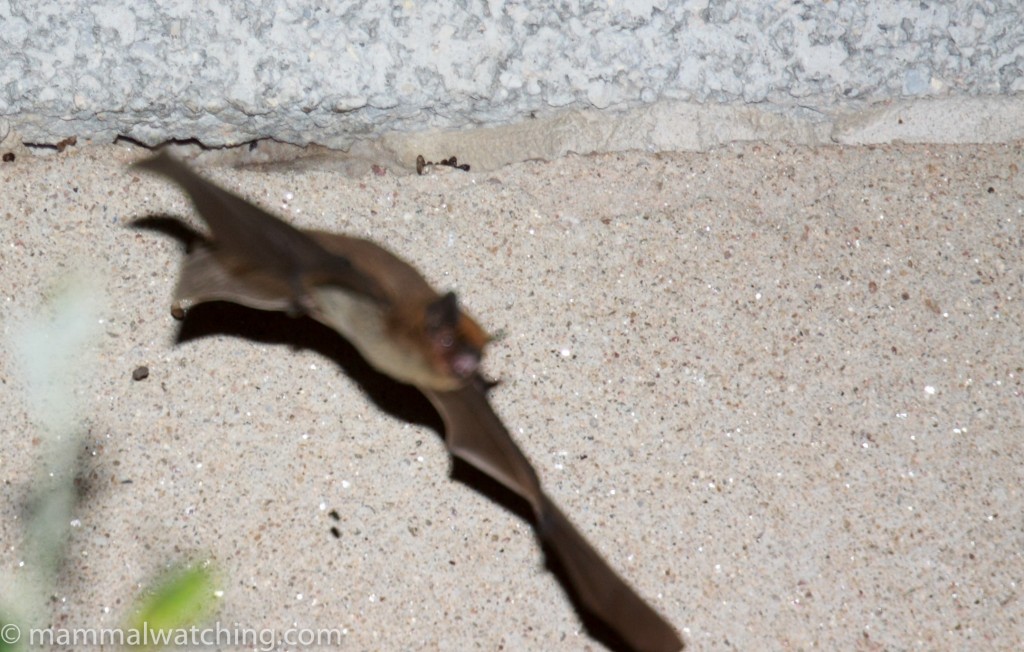
Kohl’s Pipistrelle, Pipistrelles kuhlii: note the white line along the edge of the wing membrane.
Dominique caught just one Common Pipistrelle so we left at about 11 p.m.
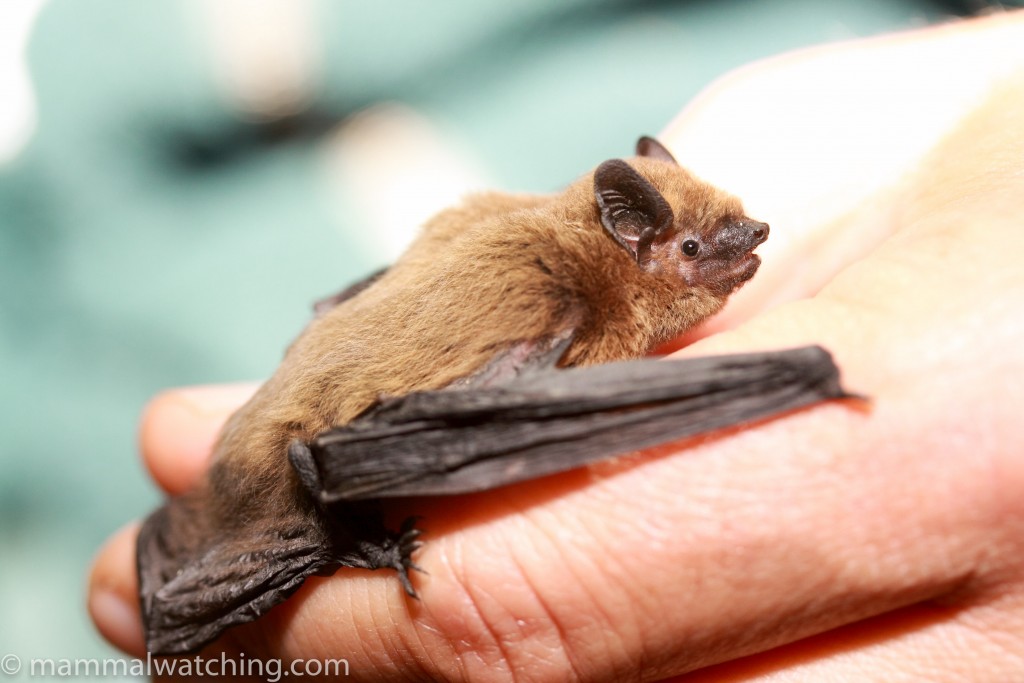
Common Pipistrelle, Pipistrellus pipistrellus
I saw a Wild Boar on the drive out of the park. Thirty minutes later, and just as we were approaching JM’s house in Toulon, Dominique phoned. He’d caught a Savi’s Pipistrelle (a lifer for me) and did I want to go and see it? Jean-Michel asked. Knowing full well the polite answer would have been “no” I gritted my teeth and admitted “Maybe….”.
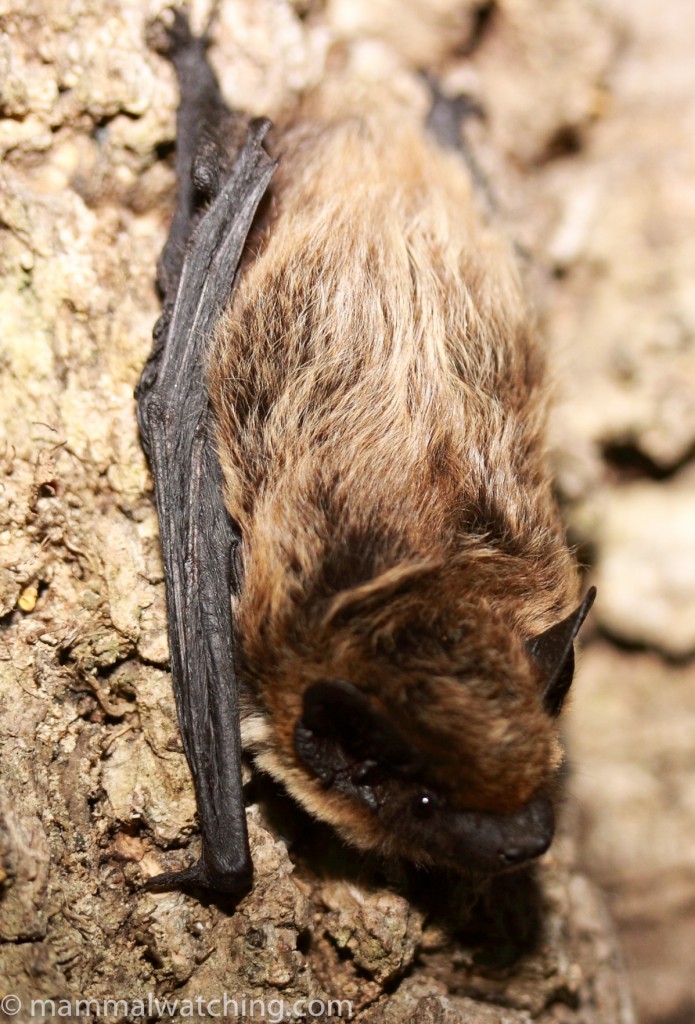
Savi’s Pipistrelle, Hypsugo savii
So Jean-Michel turned the car around and back we went. Sure enough Dominic had caught a Savi’s Pipistrelle as well as a Leisler’s Bat, my first view of this species in the hand. Jean-Michel’s willingness to stay up for another 2 hours confirmed, beyond doubt, he is a total star.
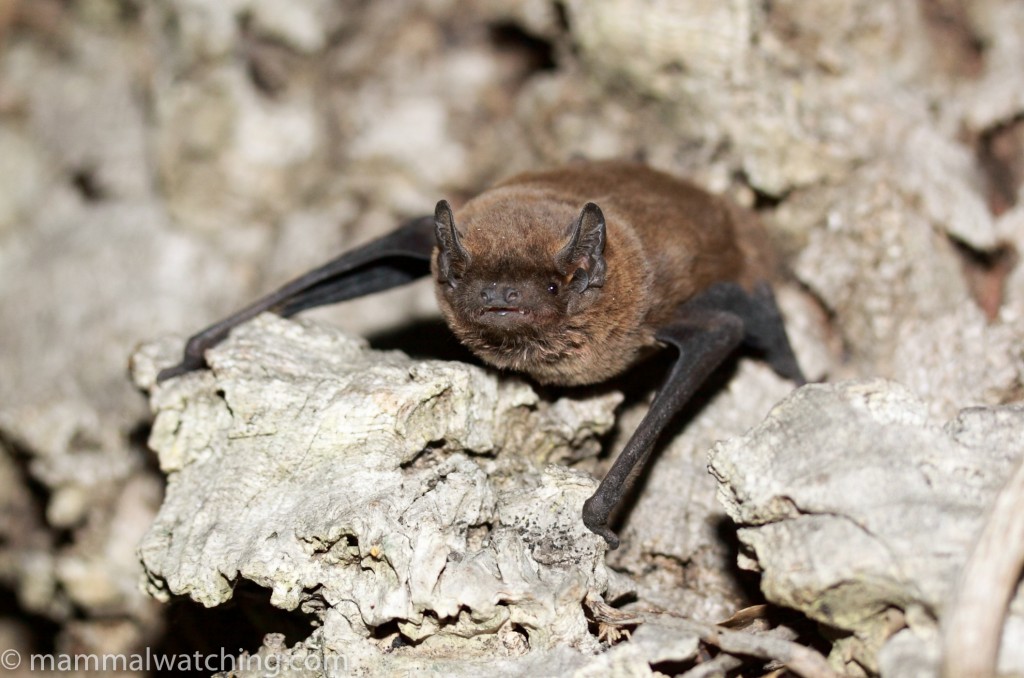
Leisler’s Bat, Nyctalus leisleri
On Sunday morning we got up early to head to the La Chapelle de Saint Pons near the village of Gemenos, about 50km from Toulon in the Bouches du Rhone departement. A colony of 20 or so Bechstein’s Bats roost in the 13th century church there.
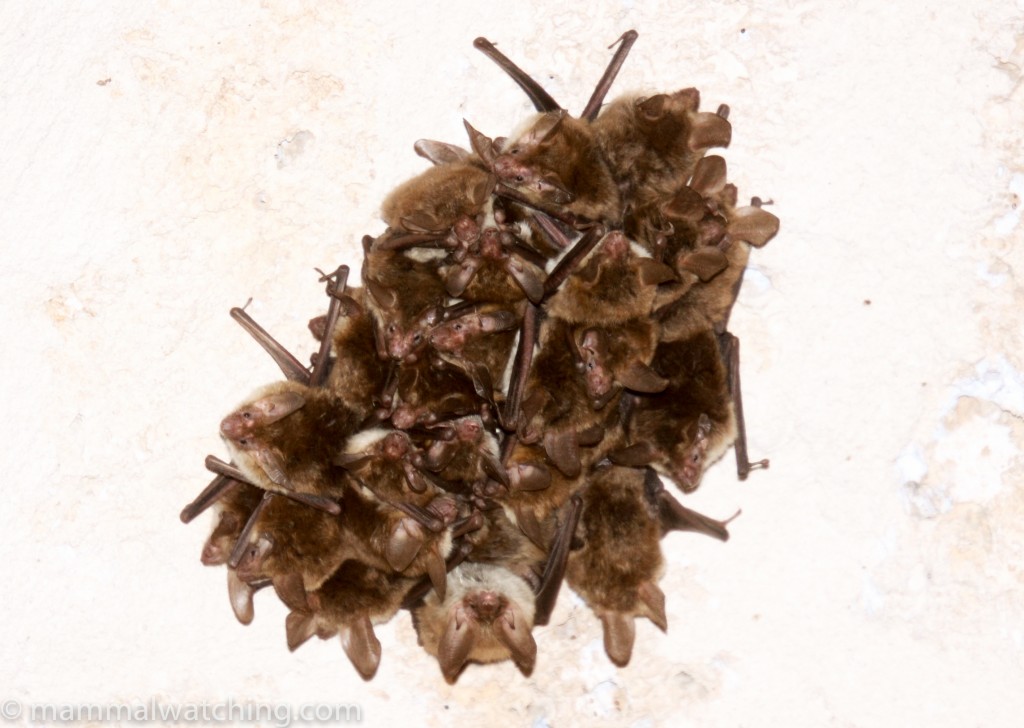
Bachstein’s Bat, Myotis bechsteinii
Though the gate is locked, the chapel is tiny and you can see the bats from outside. We met up with Laetitia Bantwell who had the key for the church and counted the bats once a week. Bechstein’s are rare in France and particularly hard to see. They usually roost in old trees, with only 7 known roosts in buildings.
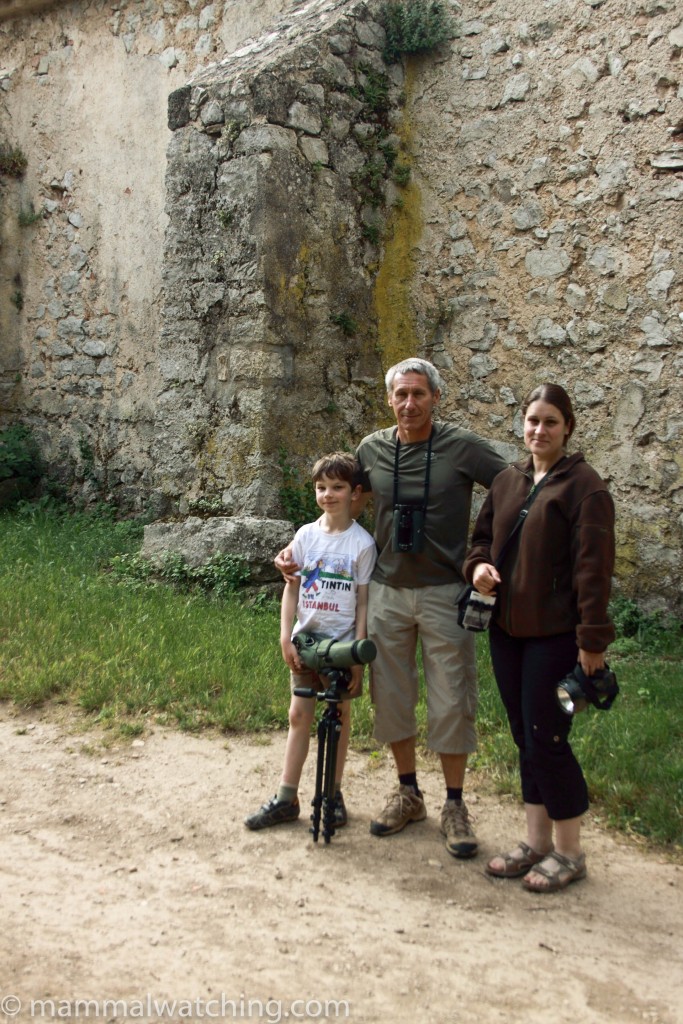
Patrick, Jean-Michel and Laetitia
What a fabulous three days! We saw 14 species of mammals, and 6 lifers for me (all bats) which was about double what I had expected. Jean-Michel was immensely generous with his time and expertise and I’m very grateful to him and Mary for their kind hospitality. I’m looking forward to returning as soon as I can.
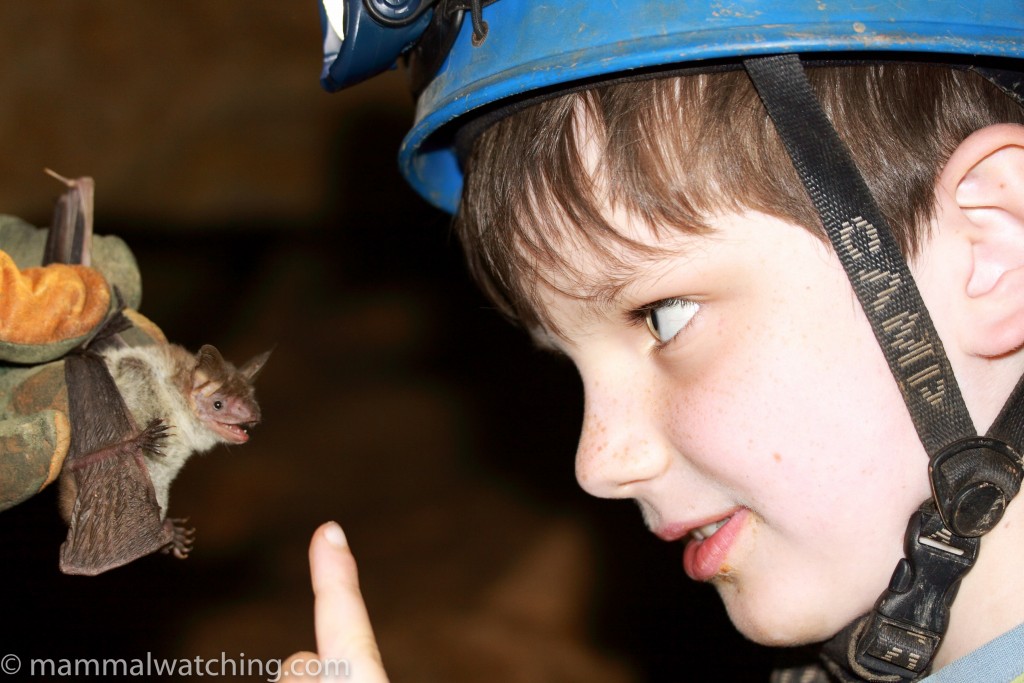
Patrick, the bat whisperer
And back I went the next year for a weekend to accompany Jean-Michel and 20 others on their annual survey of a Long-fingered Bat (Myotis capaccinii) hibernacula on the last Sunday in January 2010.
On Friday night Jean-Michel set a few traps near his place and caught me my first Algerian Field Mouse (Mus spretus) an hour after my train arrived on Saturday. Slightly smaller, cuter and less smelly than a House Mouse, the clear delineation between the venter and the flanks was a distinguishing feature as was the shortish tail.
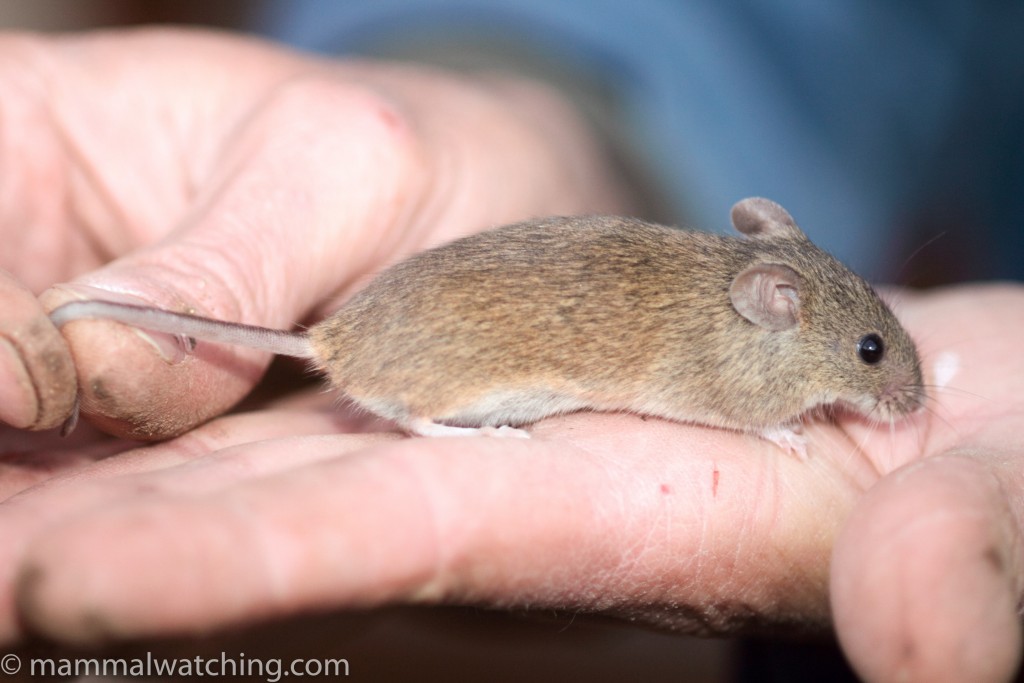
Algerian Mouse, Mus spretus
JM also set some traps for a Pine Vole, a species he had caught at the same site in the first trap he had set there but never since. We didn’t find any.
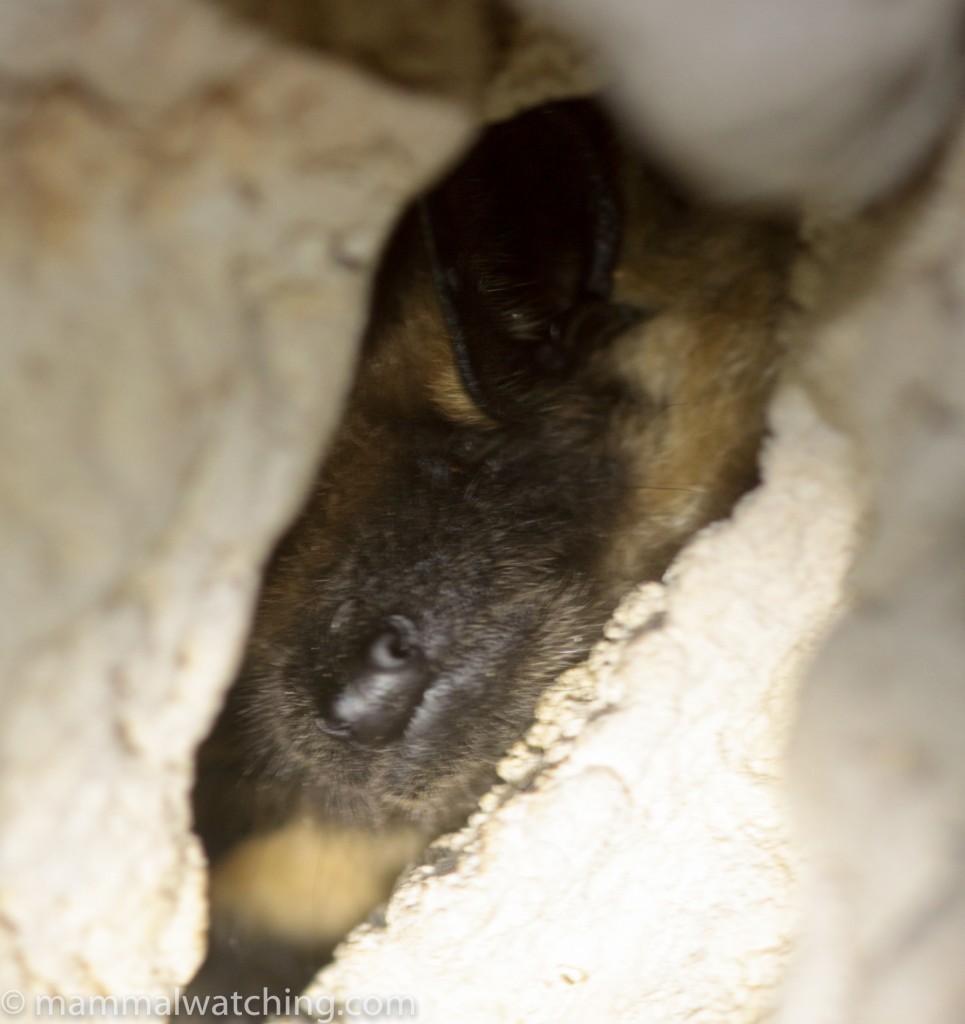
Common Serotine, Eptesicus serotinus
We spent a very very cold Sunday surveying the tunnels along the the old Canal du Verdon (a disused canal that once carried water). The canal runs along the southern side of the Gorge du Verdon, a pretty speccy gorge about an hour and a half’s drive from Toulon (or 1 hour and 10 minutes on the way back when I was late for my train and Jean-Michel proved he could have had a career as a rally driver if he hadn’t become a doctor).
The first couple of kilometres of tunnel are along a footpath that starts from the bridge just south of the village of Quinsy. These are open to the public. The rest of the tunnel system is gated to protect the bats.
In 24 tunnels, running over 3kms we counted about 80 Long-fingered Bats, 20 or so Common Pipistrelles and a lone Serotine. Other species, including Bentwings (in October and November) plus Leser and Greater Horseshoes and Grey Long-eared Bats also winter here, but we didn’t see them.
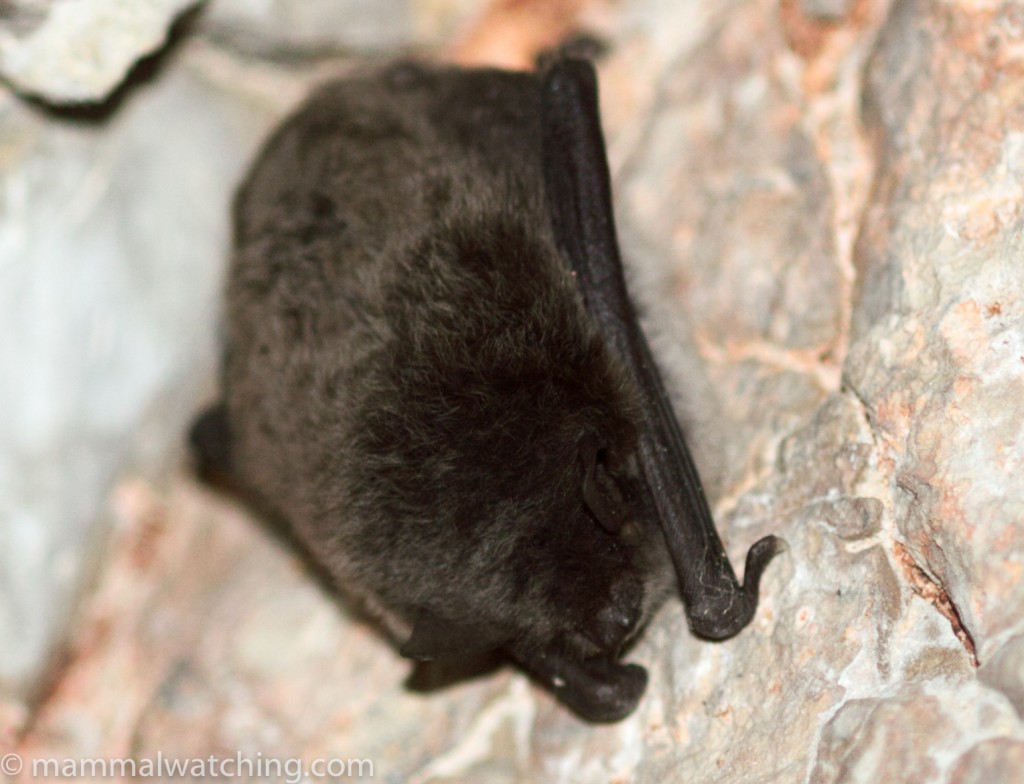
Long-fingered Bat, Myotis capaccinii
For more information on the bats of Provence visit the site Le Groupe Chiroptères de Provence (in French).
In October 2010 I was back in the south for another weekend. Forty-eight hours of torrential rain put paid to any prospects of mammal catching, though I still set traps around Greolieres-Les-Neiges, a ski station half an hour north of Grasse both nights. The stony ground around here is supposed to good for Snow Voles (they like areas with poor soil, lots of stones and few trees). But they do not, I suspect, like the rain so much.
But my other target, Southern Water Vole (Arvicola sapidus) was easy to see at the spot JM Bompar recommended: opposite the zoological parc in nearby Thorenc. The park is on the D2 road, a few kms east of Thorenc. On the other side of the D2, immediately opposite the car park, you can see a meadow with several streams running through it. The place is full of Water Voles. We saw an animal at dusk after all of three minutes searching.
I was back with my kids in Easter 2011 and we stayed at the Jean-Michel Hilton again. The weather wasn’t great. We tried to catch Pine Voles again, and caught a lot of traps full of soil but no animals. And I was unsuccessful in my attempts to catch Water Shrews and Snow Voles.
JM was more successful with the bats though, catching my target – an Alpine Long-eared Bat (Plecotus macrobullaris) – near Andon. We also caught a couple of Daubenton’s bats, saw a lot of Roe Deer around Andon and in the Camp Militaire de Canjuers, as well as what appeared to be a Polecat late at night. The Canjuers military camp, about 30km west of Grasse, is an interesting place. It has been protected for about 50 years and no people live within the area so it is now rich in wildlife. Wolves are resident and Lynxes are reported every year (mainly by jogging soldiers). Be careful if you visit: although the D25 runs through the camp, you run the risk of being arrested or flattened by a shell if you leave the road.
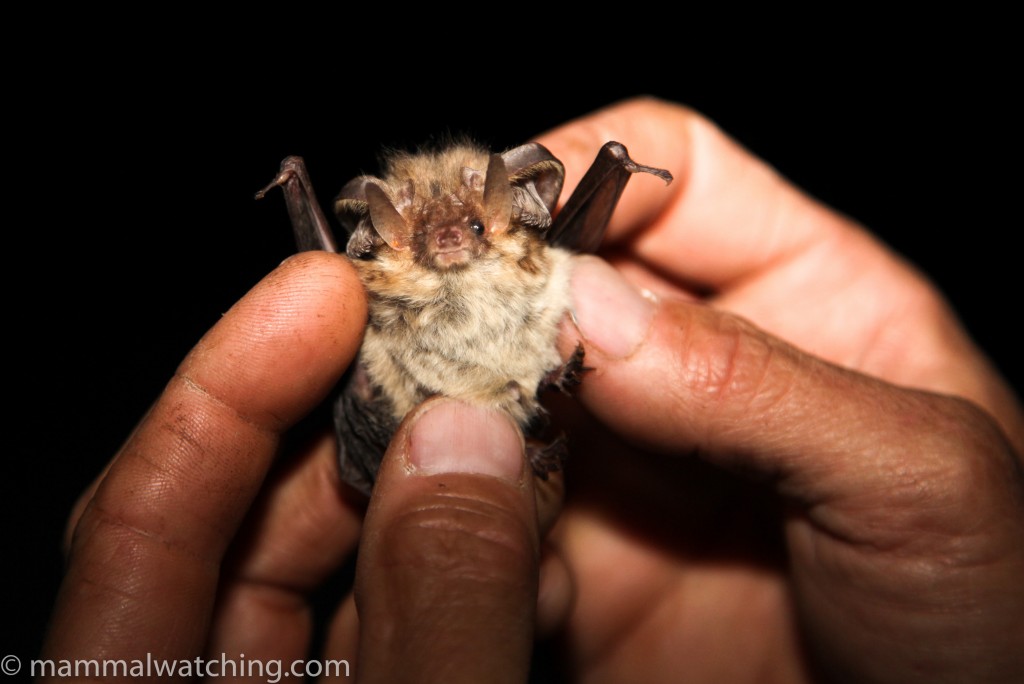
Alpine Long-eared Bat, Plecotus macrobullaris
La Brenne
La Brenne, in the very centre of France (40 km west of Chateauroux in L’Indre department), is well known among birders as a rich area, with a wetland mosaic of thousands of lakes. I liked this rural area of farmland, woods, sleepy old villages and quiet lanes. A world away from Paris with delicious, cheap food too. I spent a night here in mid-April 2006, returned the following weekend and again in July.
L’Indre, the central department of France is rich in wildlife. The local mammal list is an impressive 59 species: Polecats, Pine and Beech Martens and Garden Dormice are some of the nicer species that are apparently common (the former near water, the latter in the roofs of old buildings). Wild Cats and Genets are around, but rare, and there’s a chance that European Mink still survive in the area, though none has been seen since the 1980s. And many of France’s small mammals have been recorded including 6 shrew species, and as many voles, including Southern Water Voles.
It is an extraordinarily good place for bats. The 17 species of bats include Barbestelles, all of France’s Pipistrelles, Bechsteins and Grey Long-eareds, while Greater Mouse-eared Bats are apparently common. And in July 2006 Jean-Emmanuel Frontera caught 60 animals from 10 species in one evening! That would be a bloody good haul for the tropics, let alone Europe.
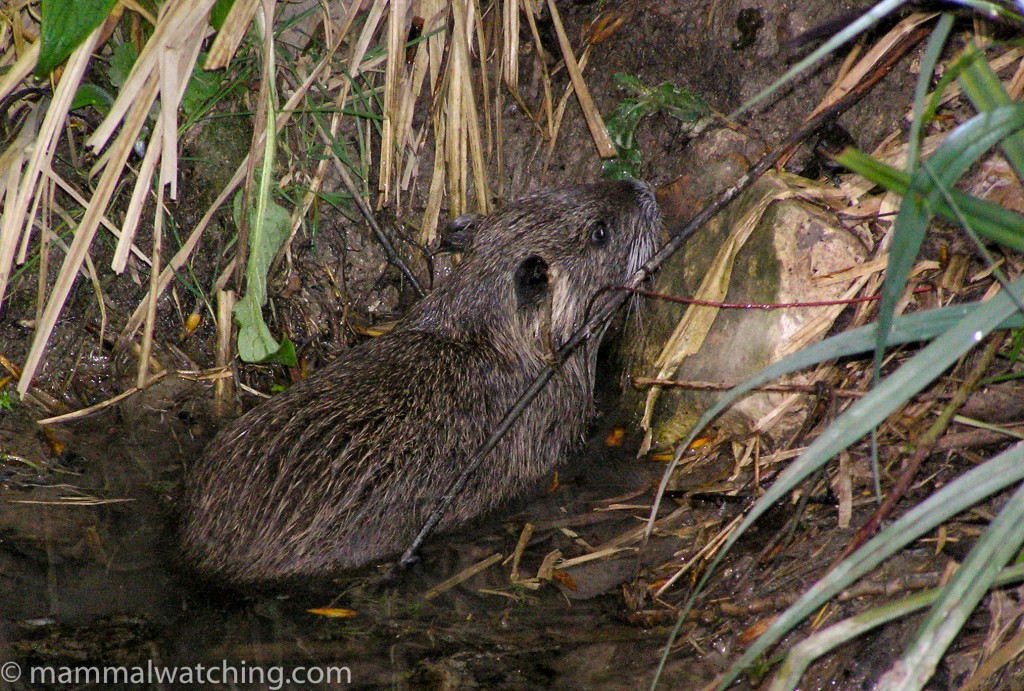
Coypu, Myocastor coypus
Feral Muskrats and Coypus are unfortunately common. Coypus (or Ragondin in French) are a pest, but an impressive pest, and I saw a couple while I was spotlighting along the Etang de Beauregard Nature Walk, south of St Michel-en-Brenne, with two in the far end of the lake at the end of the trail.
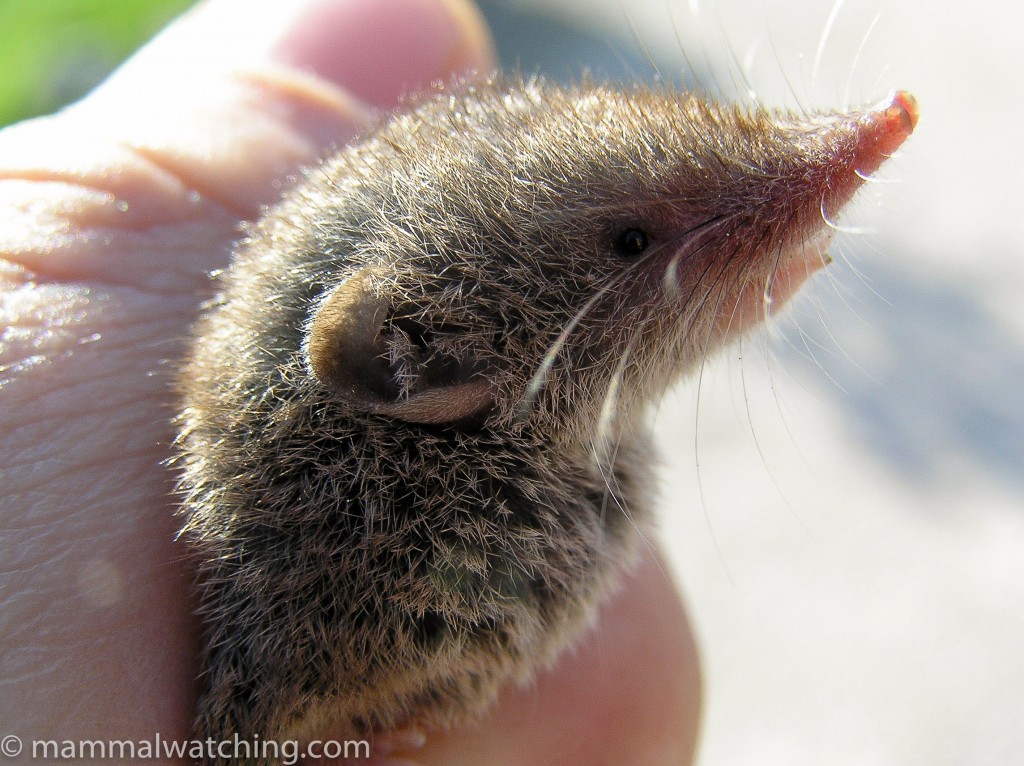
Greater White-toothed Shrew, Crocidura russula
There were heaps of Soprano Pipistrelles and Daubentons feeding along the trail and over the lake in April 2006, with Rabbits common on the road. I also caught a Greater White-toothed Shrew in the garden of the old farm where I was staying.
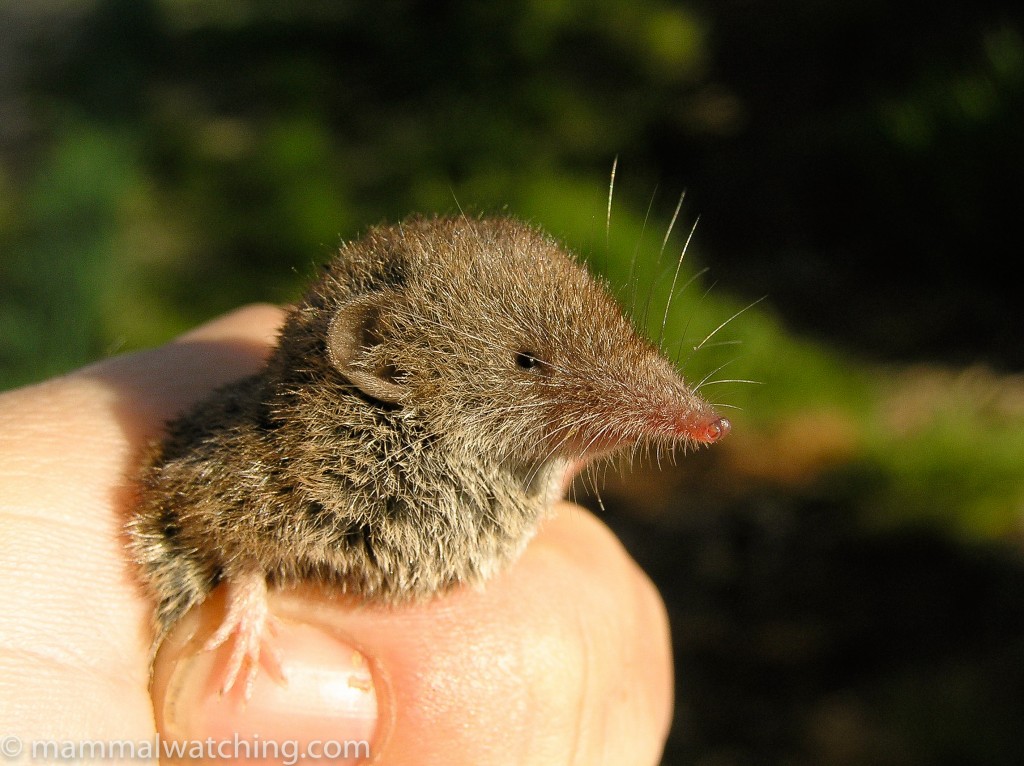
Greater White-toothed Shrew, Crocidura russula
I spent a mammal-filled morning with Jean-Emmanuel Frontera, the region’s bat expert and head the local bat association. He generously gave up a couple of hours showing me some animals (proof again that those who work with bats are perhaps the friendliest of all mammalogists). We visited an impressive network of catacombs near a chateau at Palluau-sur-Indre. Originally excavated for stone when the chateau was built, the caves/mineshafts were used as a mushroom farm until the mid 1990s when they were brought to help protect the bats. The entrance is now gated. Emmanuel said he’s recorded 13 species there in winter, including Bechsteins, Brown and Grey long-eareds and Barbastelles.
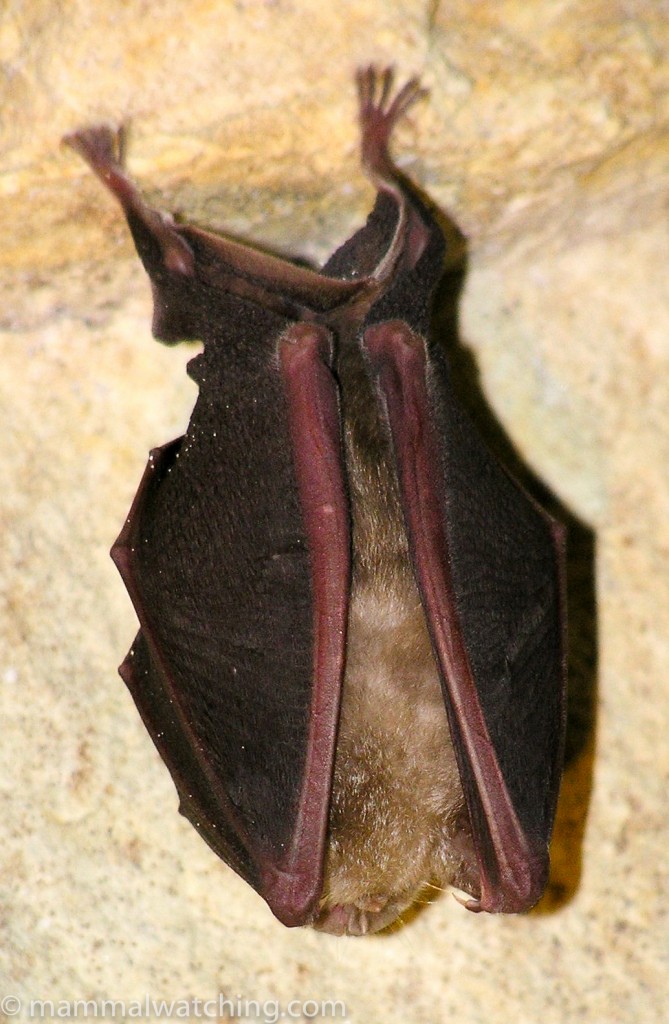
Greater Horseshoe Bat, Rhinolophus ferrumequinum
We saw a stack of Geoffroy’s Bats, a dozen or so Greater Horsehoes and a possible Daubenton’s, which flew when the light hit it. We also saw half a dozen Lesser Horseshoes, a handful of Whiskered Bats and a lone Mediterranean Horseshoes (the latter three species all new for me).
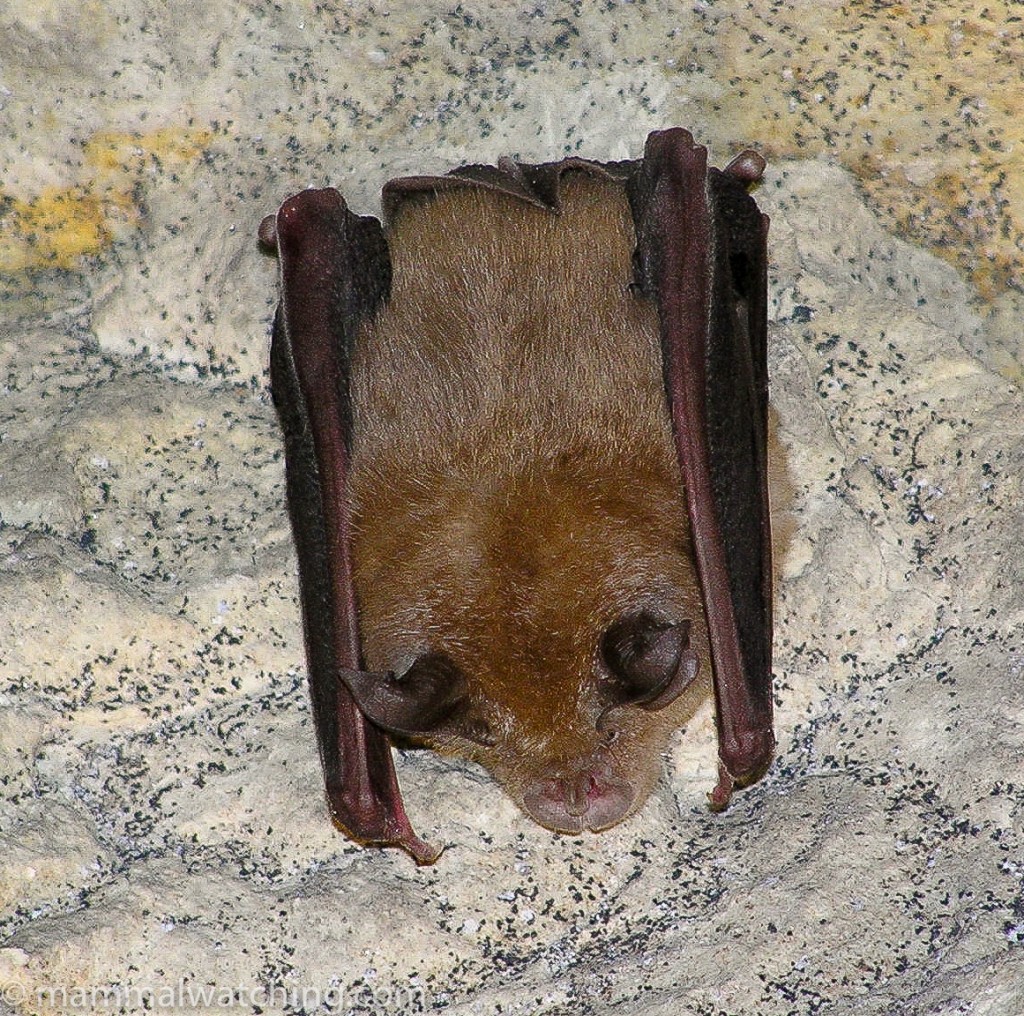
Mediterranean Horseshoe Bat, Rhinolophus euryale
From there we went to the village of Arpheuilles, where we visited an occasional Barbastelle roost (between two pieces of timber on the top of a doorway) – they weren’t there. Unfortunately the door to the belfry was locked to so we couldn’t see the Greater Mouse-eared Bat colony.
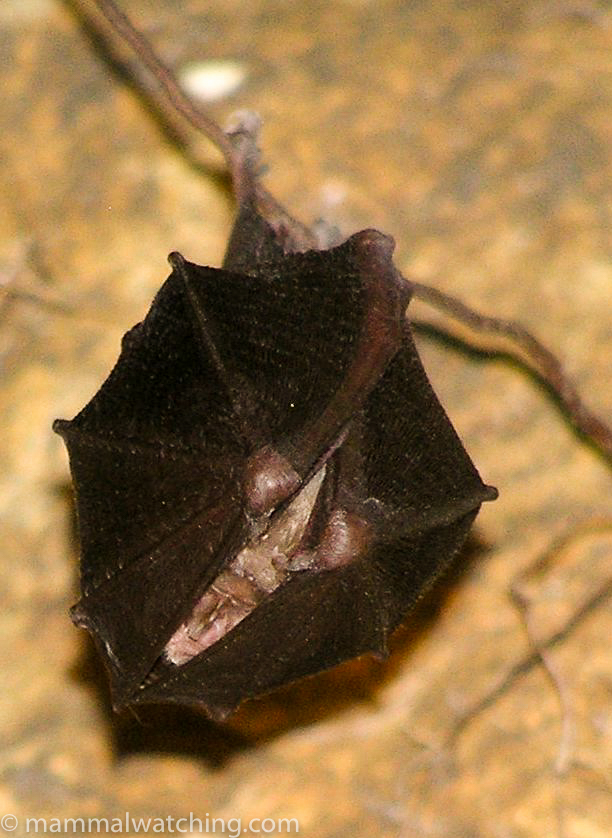
Lesser Horseshoe Bat, Rhinolophus hipposideros
I went back in July. The Arpheuilles roost had been abandoned – possibly because an owl had taken up residence in the Belfry. So Jean-Emmanuel took me to the church at Meobecq, where he found a couple of Greater Mouse-eared Bats roosting between cracks running up pillars. He was then good enough to take me on a Barbastelle hunt.
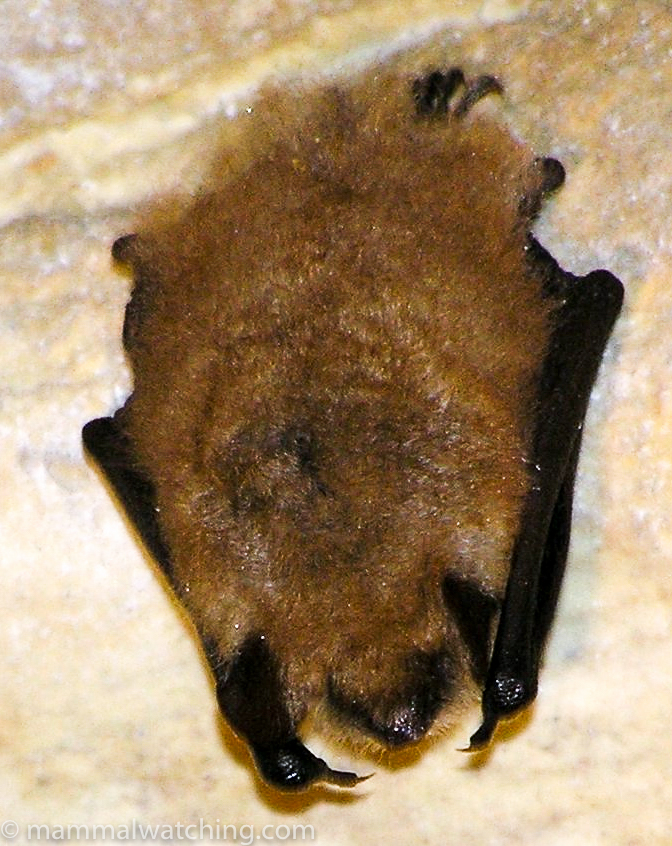
Geoffroy’s Bat, Myotis emarginatus
Several roosts were bat-less but we eventually found 8 animals roosting between the cracks at the apex of a stone arch window frame (without glass) in a farmhouse that was at least 200 years old, somewhere near Rosnay. Barbastelles have a penchant for roosting in the cracks above doorways and windows apparently. Plus there was a single Geoffroy’s bat roosting under the eaves outside the Maison du Park visitor centre.
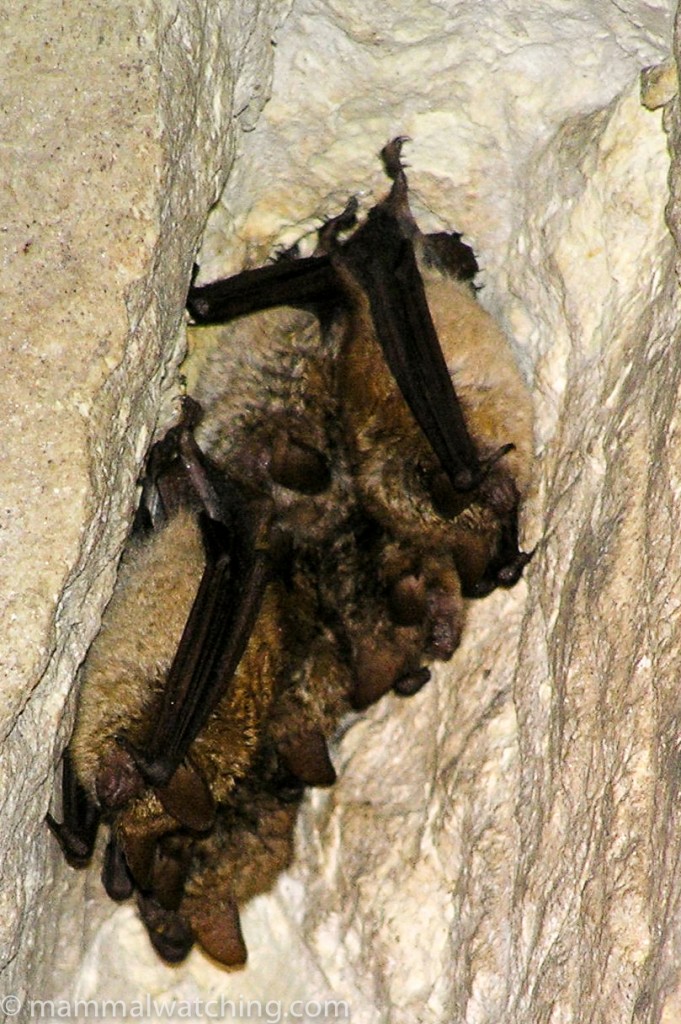
Geoffroy’s Bat, Myotis emarginatus
The Pyrenees
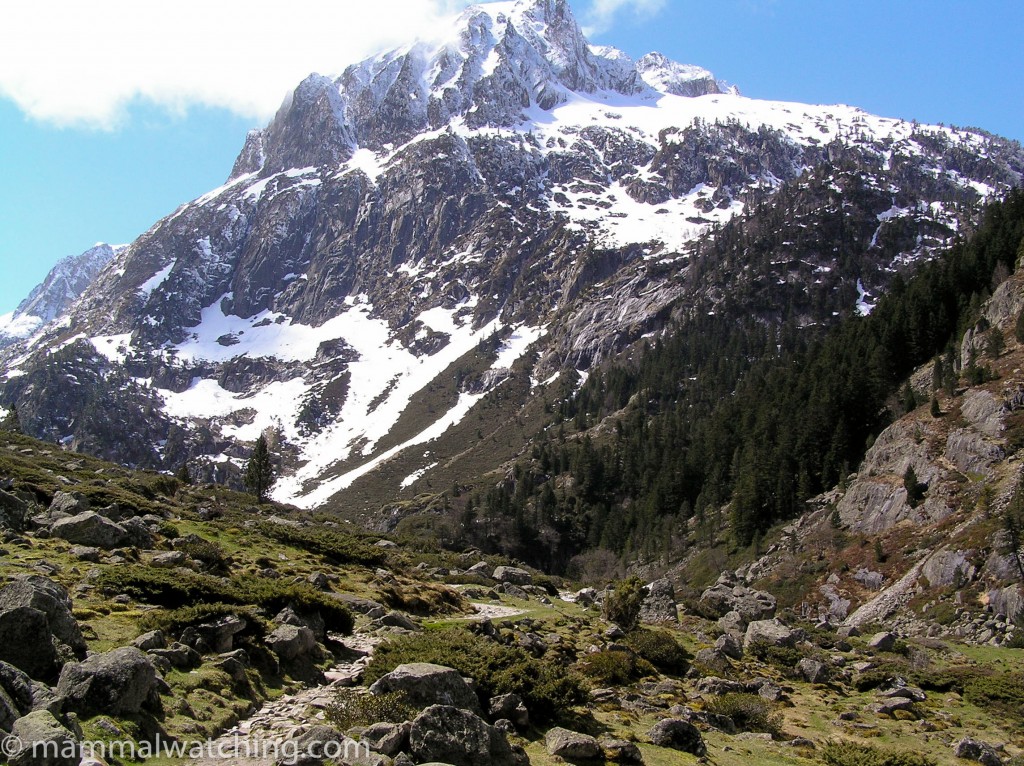
Balaitous Massif, near Lac Du Tech
I spent a week in the Pyrenees in mid April 2006. It was a more family-based – than mammal-based – holiday so I didn’t get a huge amount of time to explore.
We stayed near the village of Arrens-Marsous (south of Lourdes) and handy for the central area of the Parc national des Pyrénées. The village and immediate area was pleasant, but I was less impressed with that section of the national park. The are was heavily developed and there were heaps of people around, including a deeply disturbing number of born again pilgrims, who traveled en masse, by coach and in matching tee shirts. The scenery was pretty speccy though.
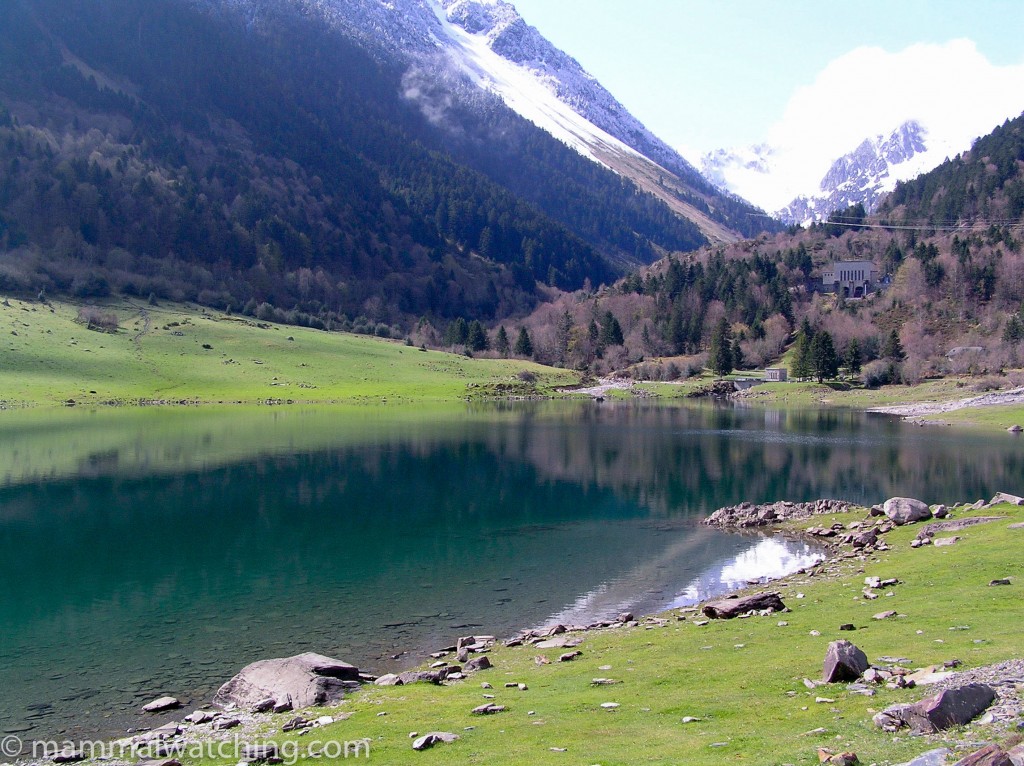
Lac Du Tech
Isards, the Pyrenean species of Chamois (a separate species to those in the Alps) are easy to find. I saw animals near Lac D’Estaing (20 minutes along the trail that leaves from the parking area at the western end of the lake). I saw others closer to the trail running from the end of the D105 (the road that runs from Arrens-Marsous past Lac Du Tech). Isards were 15 minutes along the trail, soon after you leave the pine forest on the way to the Balaitous Massif. And there were more around Pont D’Espagne which seems to be a particularly well known spot for them.
Alpine Marmots, were just coming out of hibernation when I was there and are probably much easier to spot in summer. They are reputedly common around Lac Du Tech, though the only animals I saw were near the Pont D’Espagne. They were on the south facing side of the valley about 15 minutes walk past the Chateau du Clot. Just past the chateau you cross the meadow to the right and head along the right hand bank of the river, and there were marmots on the steep grassy slopes between the scree slopes.
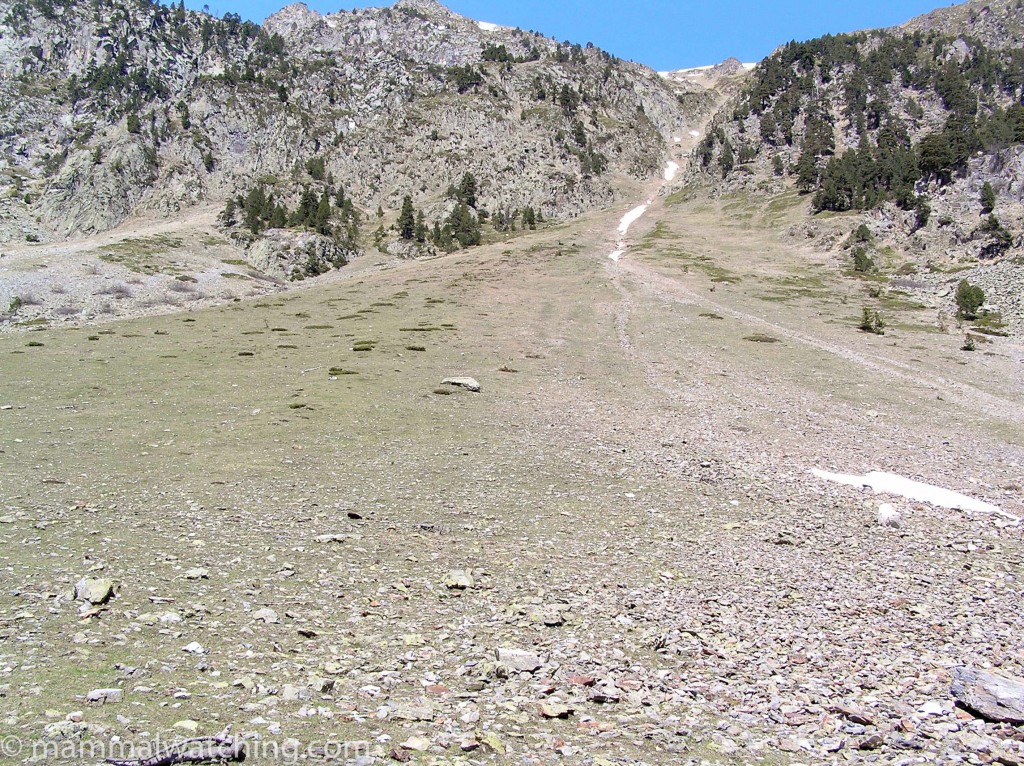
Marmot habitat near Pont D’Espagne
The guest house cat was more adept at finding small mammals than me. He caught a couple of Millet’s Shrews, a Pygmy Shrew and both Wood and Yellow-necked Mice in the garden – some of which were left alive. The Yellow-necked Mice didn’t have as much yellow on the neck as those illustrated in the field guide, but the book noted that that is characteristic of animals in the south of the range. I also saw a Hedgehog, Red Squirrel and Soprano Pipistrelle in the garden and a Brown Hare nearby.
The most interesting animal I came across was a Geoffroy’s Bat that was roosting in a weep hole in a disused tunnel along the D918 (the road that heads west out of Arrens-Marsous). The tunnel was about 10-15km after the Col de Souloir, and immediately after a small restaurant with a water wheel in its garden (on the left hand side of the road as you head west). It took me a while to convince myself of the ID of this bat but its notched ear, straight and slender tragus, medium size and absence of any noticeable hairs on the tail membrane keyed it out as one of these quite rare bats.
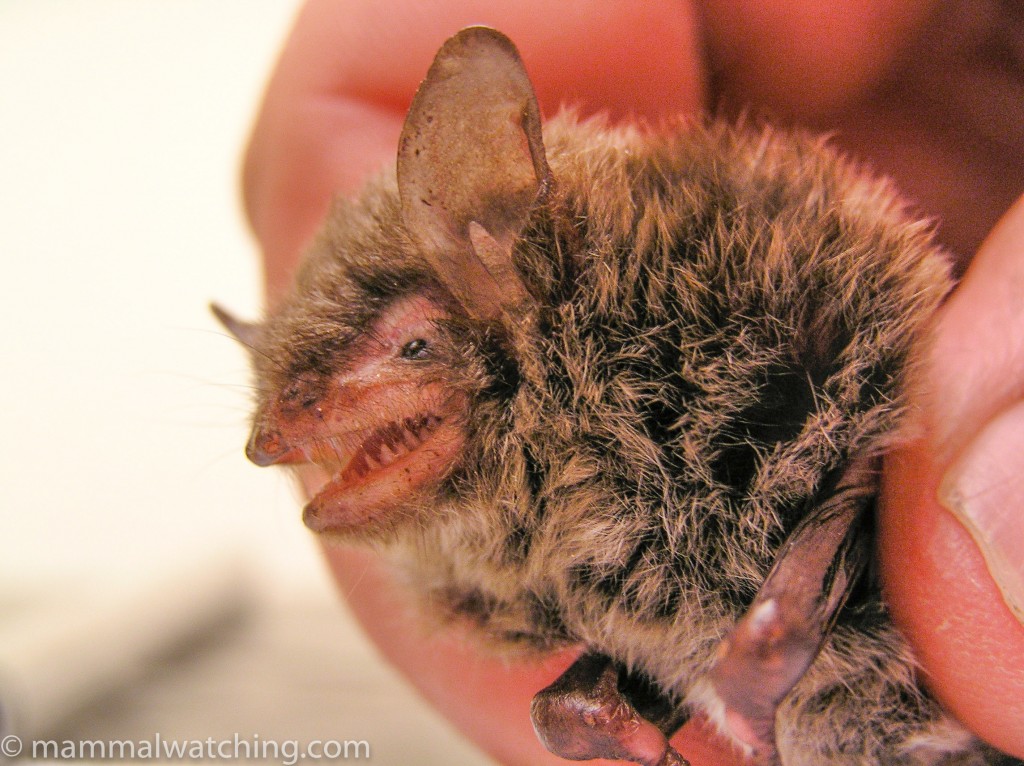
Geoffroy’s Bat, Myotis emarginatus
I didn’t get a lot of time to look for the endemic Pyrenean Desman – a bizarre beast … just think about an aquatic Elephant Shrew, which you can see stuffed in the visitor centre at Arrens-Marsous. Nor was I able to get much information on places to look. They are thought to be declining and threatened from disturbance including hydro-electric power developments that disturb river flow, as well as pollution from the road (such a salt in winter). Although their presence can be determined by their poo on exposed rocks in rivers it is hard stuff to spot: studies have found that animals were often living in rivers where no poo was to be seen. I asked a few people about them and was told that Desmans were impossible to see. A local expert said that occasionally anglers seem them in the daytime (they are mainly nocturnal but they are also active during the day and can emerge at midday to refresh themselves). If I could have found a clear, shallow stretch of stream where I know the animals are present I reckon they’d be quite spotlightable with a bit of effort, given they have to be somewhere in the stream and have a shortish home range. I eventually saw this fabulous species in Spain in 2011.
La Vendee
Is on the west coast south of Brittany. I spent a week here in July 2007. It is not the most inspiring bit of France and I didn’t search actively for wildlife other than to set some Elliott traps around the old farm I was staying in (near Aizenay). Greater White-toothed Shrews and Wood Mice were abundant. Brown Hares were common in the arable land and I saw a Musk Rat in a canal in the “Marais Mouille” (the ‘green venice’ which for the most part is also as crowded as Venice).
The Vercors
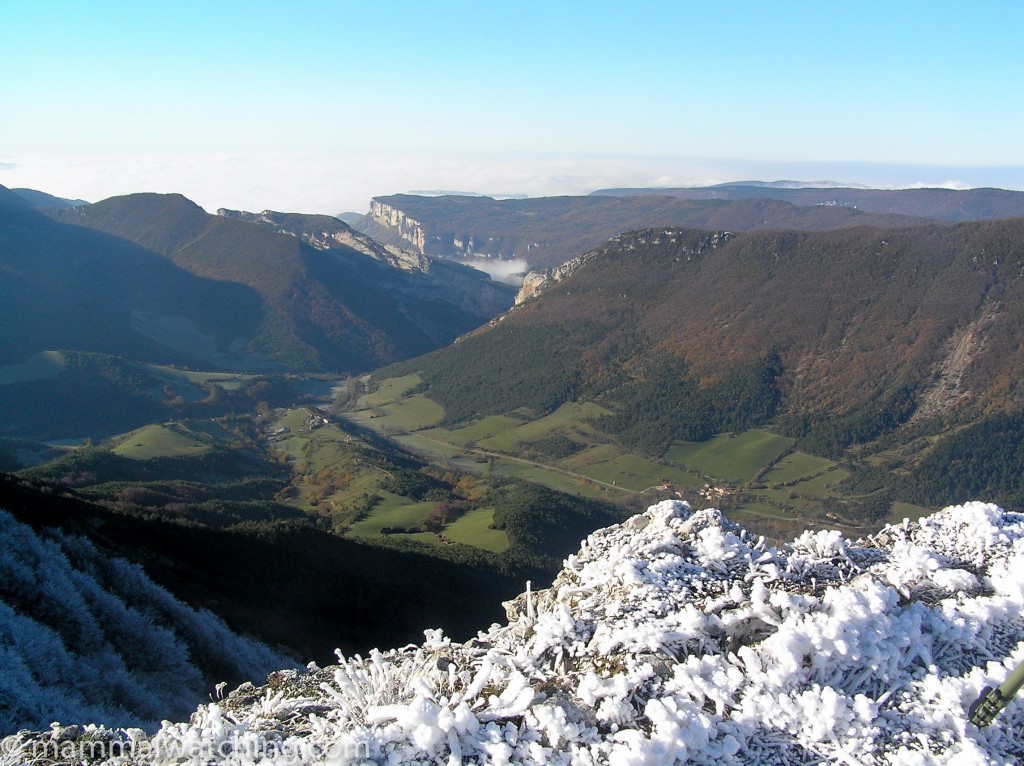
The Vercors is spectacular
My first mammal watching trip after I arrived in France was for a weekend in the Vercors region, near Grenoble in the south east, in November 2005
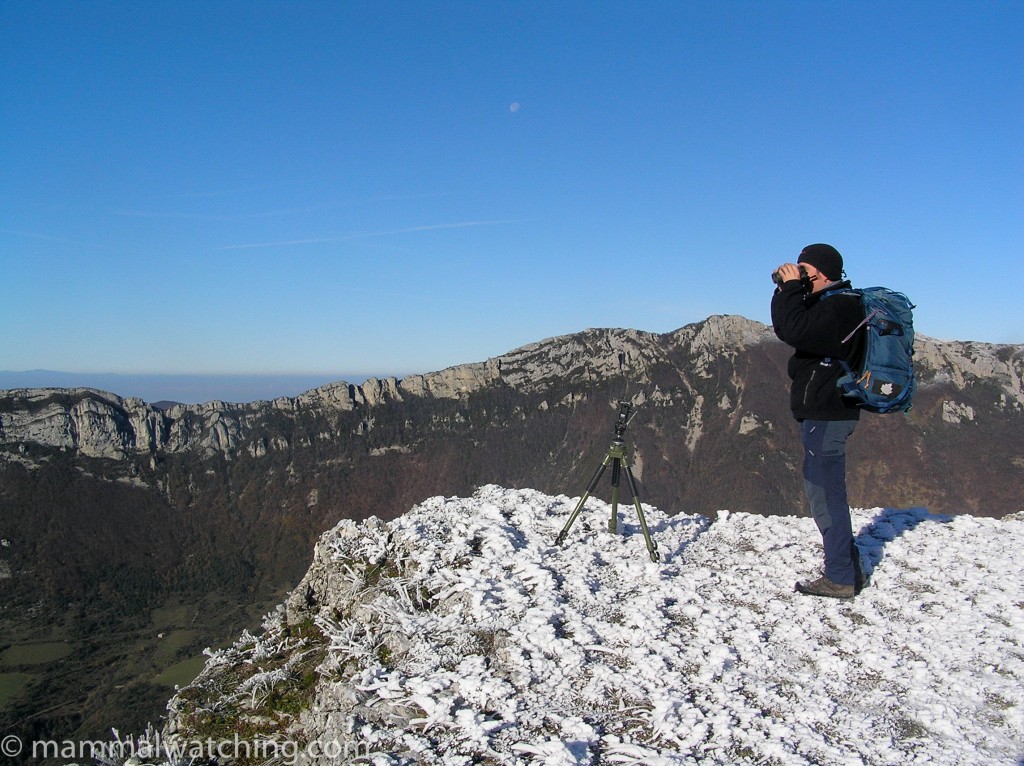
The Vercors borders the Alps. It is scenically stunning, quite sparsely populated (by European standards at least) and a pretty good for mammal watching, especially ungulates. The best time of year to visit from a mammal spotting point of view is probably October, when alpine species like Ibex and Chamois are fairly easy to see, but before the temperature gets too cold. I was there in late November. The first snow was falling, and the higher parts of the park were carpeted in a blanket of ice. But there were plenty of mammals.
I stayed at a fabulous little hotel called Auberge du Pionnier. Cheap, friendly, the food is excellent and slap bang in the middle of the forest. The owners are very interested in wildlife and can arrange for a guide to take you into the mountains for a day. I went out with a bloke called Philippe Lloret who was good company and worked hard to find me Moufflon and other mammals, plus he knew his stuff. Another local guide, who is knowledgeable about the mammals is Gilles Trochard. He runs wildlife trips around the world and he gave me stacks of information over dinner one night.
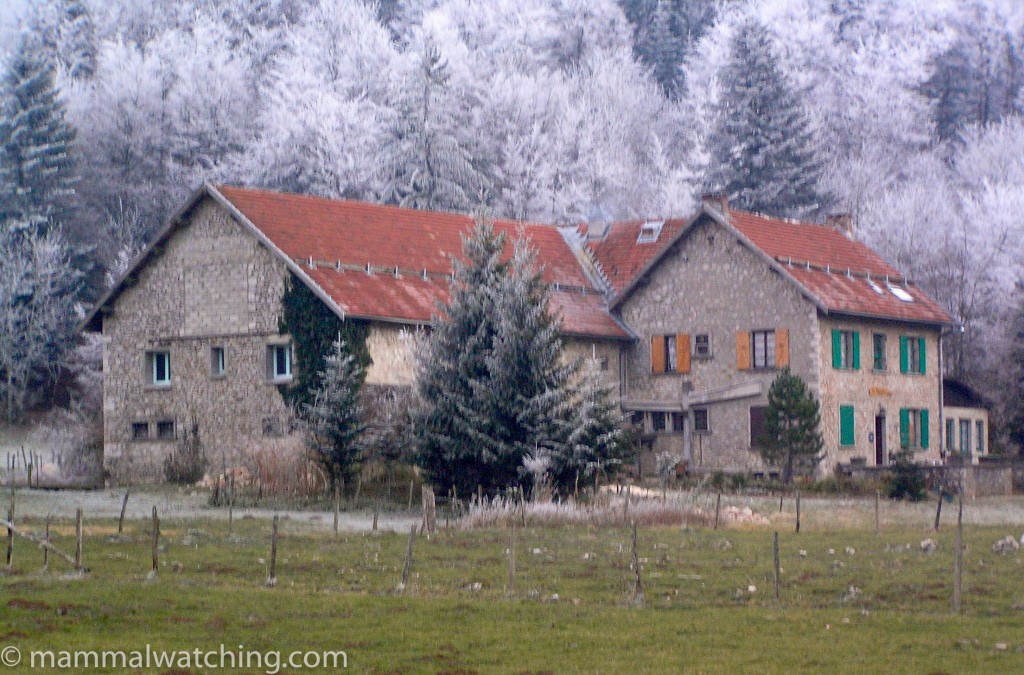
Auberge de Pionnier
Chamois were pretty easy to find on many of the mountain summits: we saw dozens during a day’s walking. Moufflon, introduced in the 1950s, were more difficult but I got distant views through the scope of two groups. A reintroduced population of Ibex are around too, and the Cirque d’Archiane is the place to look.
I went spotlighting in the car both nights I was there. It was freezing cold (about -10c and my fingers were numb after 5 minutes of holding the spotlight out of a moving car), but reasonably productive.
Red Deer were common as were Red Foxes and Brown Hares. Roe Deer are around (I saw a couple) as are Wild Boar (I didn’t see any). Interestingly there were a lot of mice running around, which was a seasonal thing. These were either Wood Mice or Yellow-necked Mice, probably the latter given the altitude.
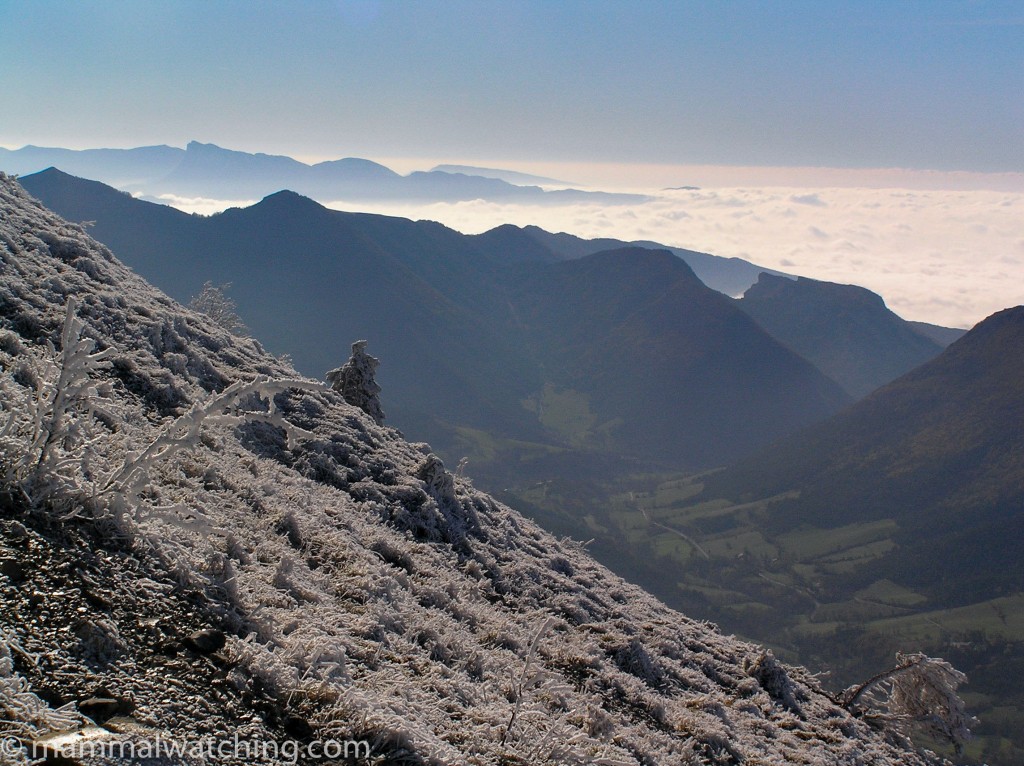
Badgers, Beech and Pine Martens, Stoats and Weasels all feature on the park list, though are not seen all that often by the sounds of things. Over the past few years a few Wolves have begun to recolonise the area from Italy. This, as always, is causing some local angst among the farmers. Angst, coupled with the French love of shooting things means one Wolf has already been shot, or so I was told, with the killing sanctioned by the Government.
Although there are Ibex are in the Vercors, they are reintroduced, so purists might prefer to see an original population nearby. On the advice of Gilles I left the Vercors and drove the 3 hours or so to the little village of St Martin de la Porte, a few km south east of St Jean de Maurienne (about 60km east north east of Grenoble). Scan the scree slopes to the east of town to find the Ibex.
There are also plenty of Marmots which should be visible between April through October. Garden Dormice are also reputedly common in the warmer months: Phillipe said they lived in most of the hiking shelters/refuges in the park.
Paris
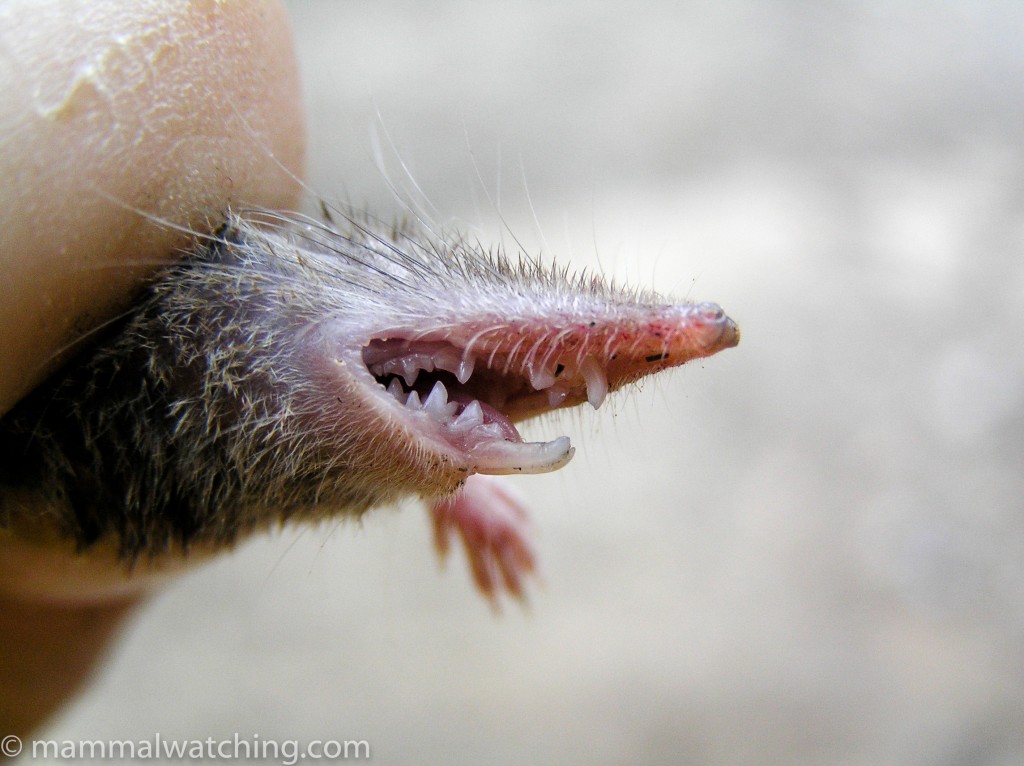
Greater White-toothed Shrew, Crocidura russula
I’ve been small mammal trapping a few times in the forest at Mariel-Marly, where I used to live. This is to the south-west of Paris near St Germain en Laye. There were plenty of Wood Mice and Bank Voles there, along with Wild Boar, Red Squirrels, Hedgehogs and Roe Deer. I have also caught Greater White-toothed Shrews here.
Keep your eyes open wherever you are in this area for Beech (Stone) Martens: I once saw one at 3am on a backstreet in St Germain en Laye during an enforced walk home. At 3am in St Germain it seems you have more chance of finding a Beech Marten than you do a taxi… I also saw a Beech Marten in my back yard in L’ Etang La Ville (near St Germain En Laye) and caught my only Nathusius’s Pipistrelle there too in a harp trap in my yard.
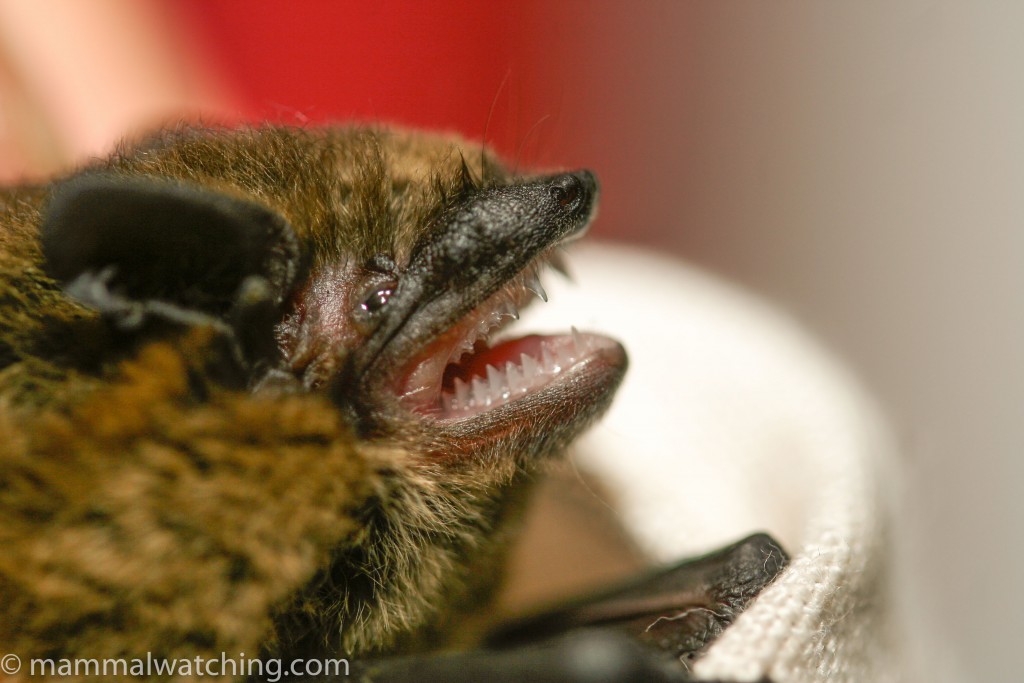
Nathusius’s Pipistrelle, Pipistrellus nathusii
Community Reports
Southern France, Spain & Gibraltar, 2023: Lorenz Achtnich, 19 days & 17 mammal species including Iberian Lynx, Eurasian Otter, Iberian Hare & Schreibers‘ Long-fingered Bat.
Refuge Ayous, 2021: Jacob Lotz’s detailed report of a successful search for Pyrenean Desman.
Abruzzo National Park and the French Alps, 2020: Dominique Brugiere, 17 days & many species including Brown Bear, Wolf, Pine Marten and Savi’s Pine Vole.
French Whale Watching, 2020: Samuel Marlin’s report of opportunities to see several nice species off the south of France including Fin, Sperm, Pilot and Cuvier’s Beaked Whale.
Desman Hunt, Pyrenees, 2020: Ben Balmford, 4 nights and a Desman.
Chartreuse Mountains (Grenoble): Ralf Bürglin , 2 days & 3 species including Moufflon and Charetreuse Chamois.
Operation Desman, 2018: Samuel Marlin’s account of seeing Desman several times around Lacs D’Ayous in the French Pyrenees.
Spain and France, 2017: Ben Schwienhart’s notes of a few mammals including a seemingly reliable site for Pyrenean Desman (in Spain).
Corsica, 2016: Ralf Bürglin, 10 days & 7 mammals including Pine Marten and Greater White-toothed Shrew.
The Jura, 2016: Karl Van Ginderdeuren’s account of two Lynx sightings on the same March day.
France & Spain, 2014: Mike Richardson, 2 weeks & 20 species including (in France) Lesser White-toothed Shrew, European Free-tailed Bat and Long-fingered Bat.
France, Andorra, Spain & Gibraltar, 2014: Vladimir Dinets, 1 month & 65 species including Cabrera’s and Mediterranean Pine Voles, Iberian Lynx, Iberian Hare and European Polecat.
Courtineau Valley, 2013-14: Romain Bocquier’s list of sightings around his home near Tours, with 33 species including some nice bats (Bechsteins, Barbastelles, Grey Long-eared), Pine Martens and European Beavers.
France, 2013: Coke, Som and Cokie Smith, a week & 6 species including Edible Dormouse and Chamois.
The Alps, 2012: Michal Polanski and some notes on Marmots, Chamois and a Garden Dormouse.
France and Italy 2008: Mark Hows, 8 days and a few mammals including feral Pallas’s and Finlyason’s Squirrels.
Also See
Chamois in Besançon, April 2024
Mammals and people sharing the same land, the south of France – a web series video (December, 2020)
RFI Chamois near Grenoble in the summer (June, 2017)
Fin Whale watching near Perpignan (May 2017)
Otter watching in Corrèze, central France (May, 2015)
Photographing bats in the Pyrenees (August, 2014).
These rental cottages in southern Brittany are, I’m told, home to a large colony of Pipistrelle’s which can be viewed each evening, with olther wildlife including badgers on the grounds.
RFI – mammals in France and Spain (Sep, 2011).
Resources
List of mammals for the Loire Valley.
Le Groupe Chiroptères de Provence website has information on the bats of Provence (in French)
The French Mammal Society website (in French)


Leave a Reply
You must be logged in to post a comment.